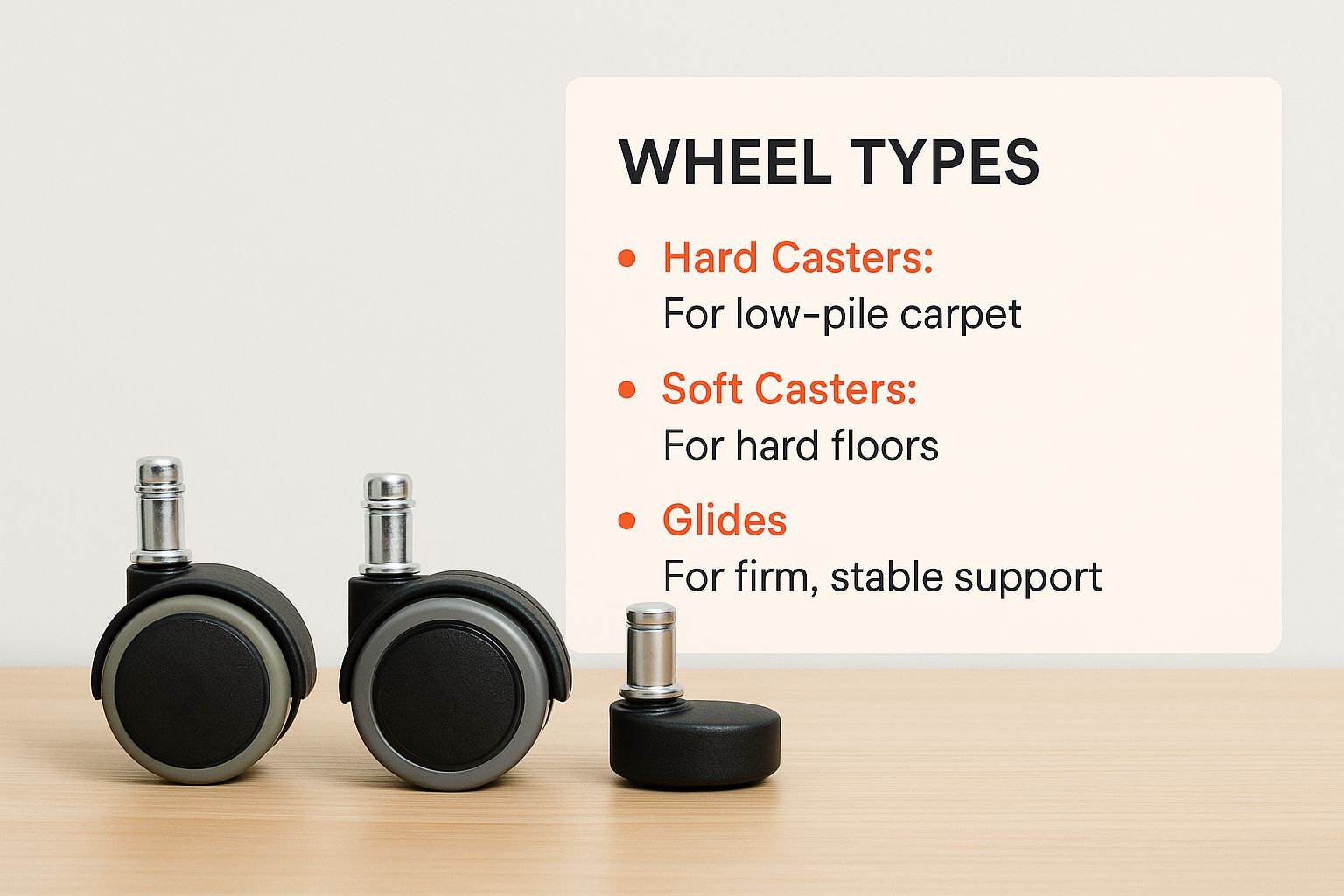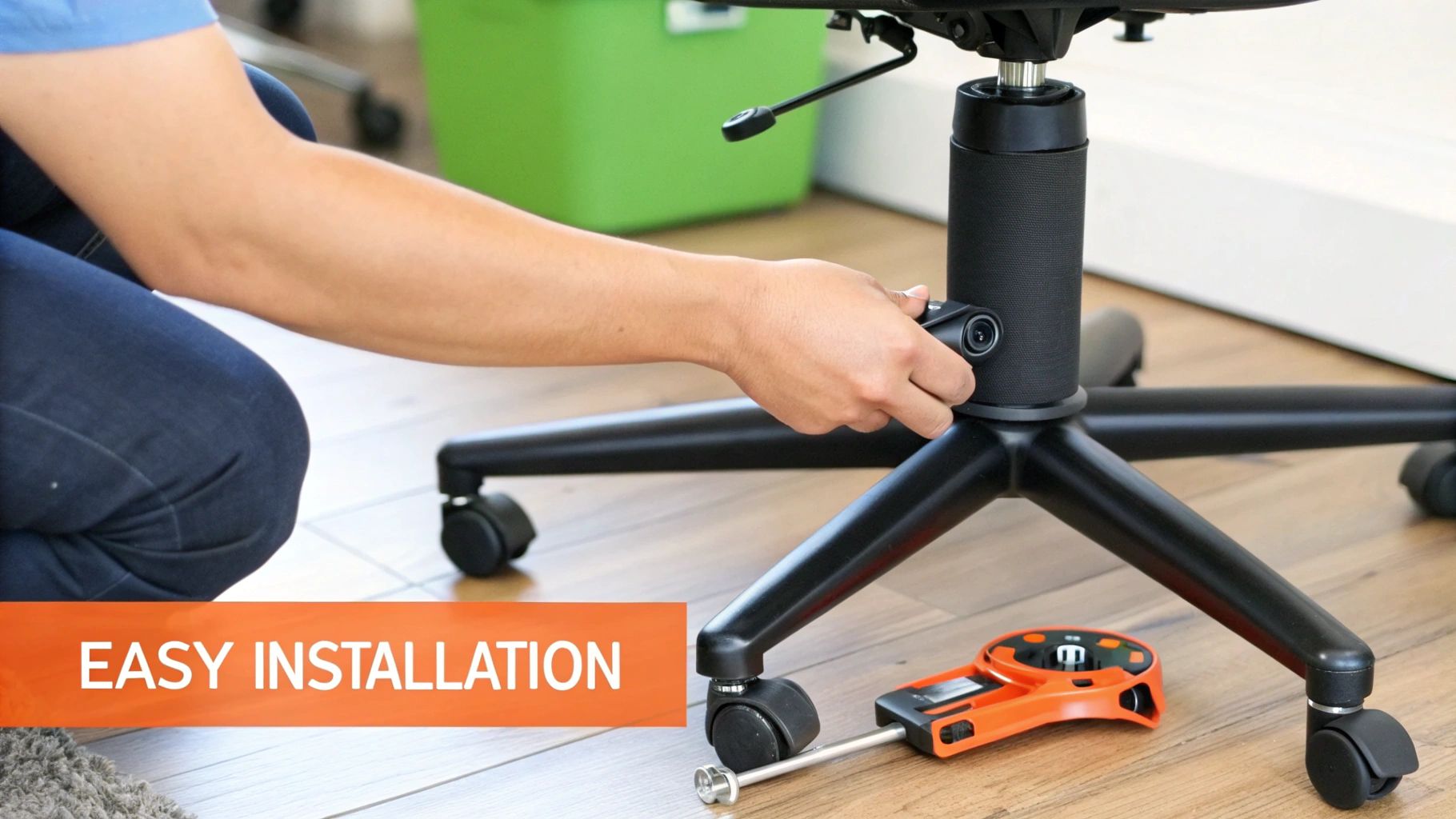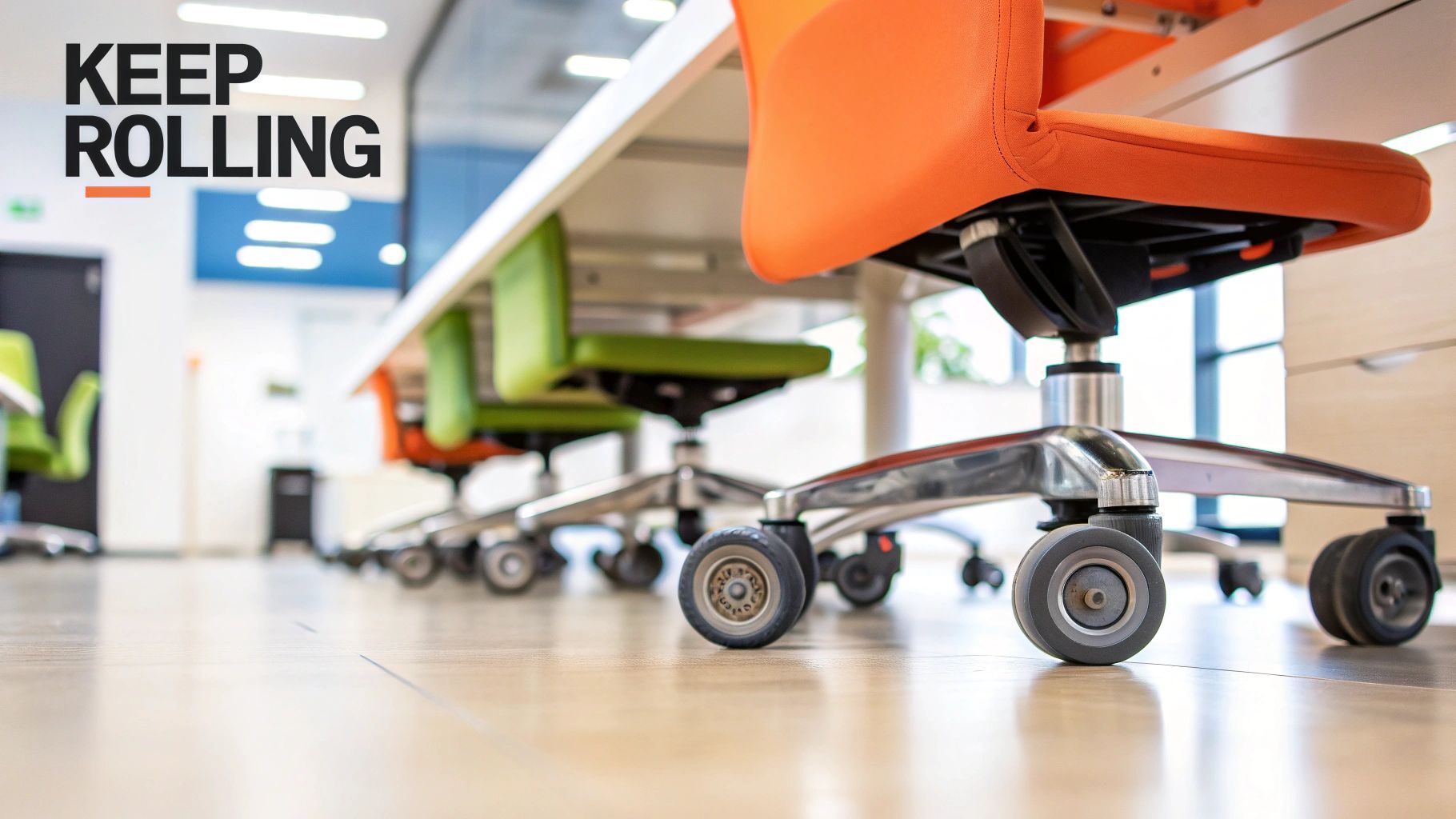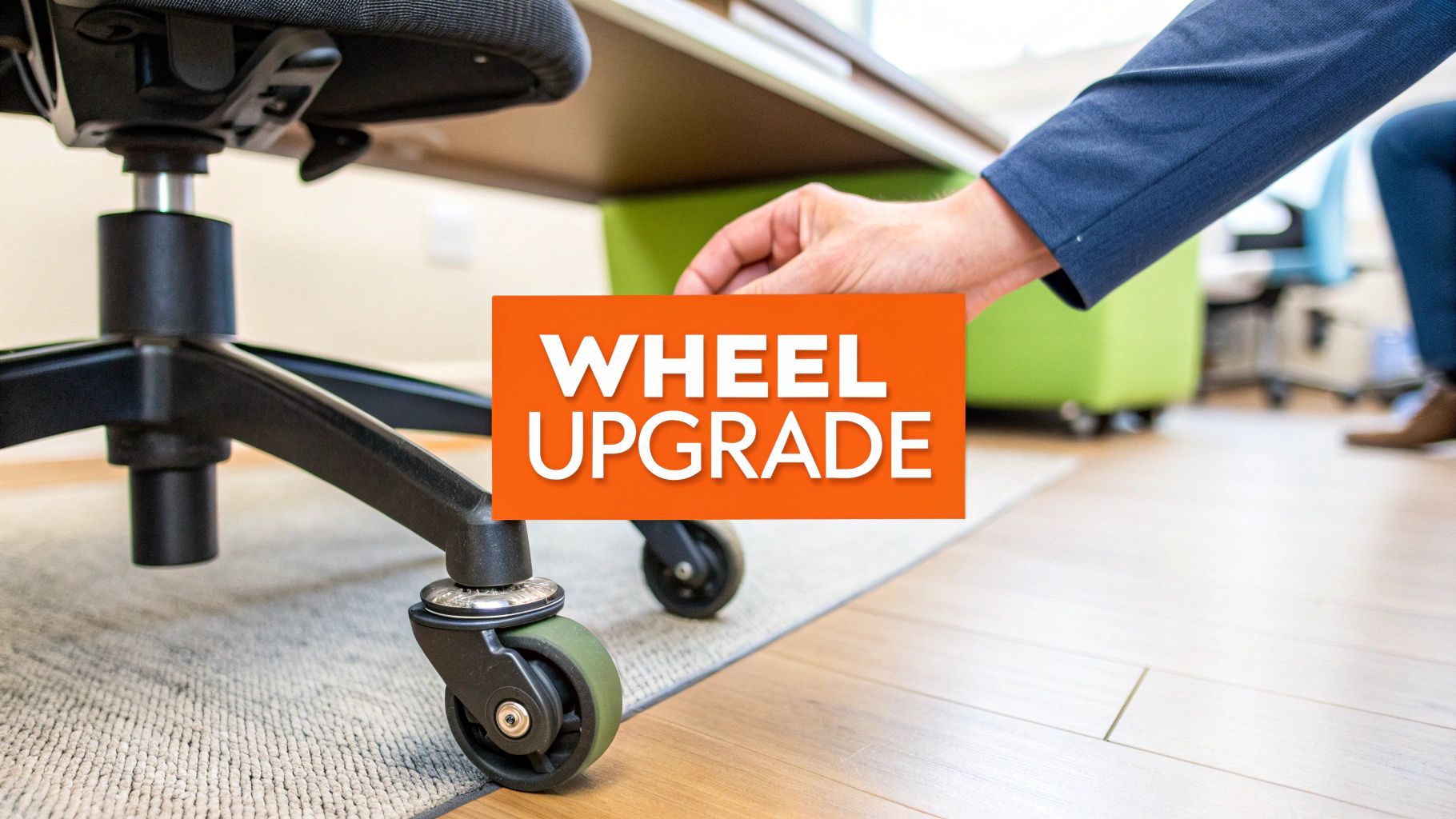That sticky, grinding sound your office chair makes isn't just a minor irritation. It's a cry for help. When your chair refuses to roll freely, it’s a sure sign that the wheels have had their day. Thankfully, a set of office chair replacement wheels is a straightforward fix that can bring back that smooth glide and protect your floors, all without the expense of a whole new chair.
Why Bother Upgrading Your Chair Wheels?
Let's be honest, the standard casters that come with most office chairs are usually the first component to give out. They're often made from basic, hard nylon or plastic, built to meet a price point, not for years of heavy use. Over time, that's what leads to that annoying drag when you're just trying to scoot across your workspace.
It's More Than Just Annoying
Worn-out wheels aren't just a nuisance; they cause real problems that can mess with your workday and even your health.
- Scratched and Damaged Floors: Those cheap, hard plastic wheels are notorious for leaving deep scratches, scuffs, and even permanent grooves on nice surfaces like hardwood, laminate, or vinyl. Repairing that damage can be a costly headache.
- Broken Concentration: Constantly having to wrestle with your chair to get it into the right spot pulls you out of the zone. That little bit of physical effort, repeated dozens of times a day, really adds up and drains your mental energy.
- Physical Wear and Tear: When a chair doesn't glide, you end up using awkward, jerky movements to shift around. This can put a surprising amount of strain on your back and shoulders over time.
- Serious Safety Risks: A cracked or broken wheel can catch on the floor without warning, creating a genuine tipping hazard. A stable, mobile base is a non-negotiable part of good office ergonomics and safety.
A good chair is an investment in your comfort and health, no doubt about it. But that investment is only as strong as its weakest link—and that's almost always the wheels. Swapping them out is probably the most cost-effective upgrade you can make to your entire desk setup.
A Smart, Sustainable Fix
Opting to replace your chair's wheels isn't just about fixing what's broken; it's a savvy move. Here in Australia, a quality office chair might last you 7 to 10 years, but the wheels often wear out far sooner. This makes grabbing a new set of office chair replacement wheels a smart, sustainable, and budget-friendly choice.
Instead of turfing a perfectly functional chair, you can give it a new lease on life. It's a simple DIY job that takes just a few minutes but makes an immediate, satisfying difference.
Of course, if your chair has more problems than just the wheels, it might be time for a complete replacement. Our office chair buying guide is a great resource for figuring out what to look for.
How to Choose the Right Replacement Wheels
Picking the perfect new set of wheels for your office chair might seem like a small detail, but it can completely change how your chair feels and performs. Get it right, and you'll be gliding effortlessly. It all comes down to matching the wheels to three things: your chair's base, your floor type, and how you work.
Let’s walk through how to choose with confidence.
First Things First: Measure the Stem
Before you get caught up in fancy materials or colours, there’s one measurement that matters more than anything else: the stem size. This is the little metal peg that slots the wheel into the chair’s base. If you get this wrong, the wheels either won't fit at all, or they'll be dangerously loose and wobbly.
Most office chairs here in Australia use a standard 11mm diameter grip ring stem. But don't take that as a given. I've seen plenty of chairs, especially older models or some European designs, that use a 10mm stem instead.
The only way to know for sure is to pop one of your old wheels out and measure the metal pin. A quick check with a ruler or a set of callipers will save you the massive headache of having to return the wrong set.
Match the Wheel Material to Your Floor
Once you've got your stem size sorted, the next big decision is the wheel material. This choice is crucial because it directly affects how your chair moves and, more importantly, whether it damages your flooring. Using the wrong wheels is a fast track to scratching up beautiful floorboards or getting stuck on a plush rug.
Let's look at the common types of wheels you'll come across.

The image above gives you a good idea of the visual differences, from standard hard plastic casters to the much smoother, rollerblade-style wheels that are a lifesaver for delicate surfaces.
To make this even easier, here’s a quick reference table to help you find the best material for your specific floor. Choosing the right one prevents damage and makes sure you can glide around smoothly.
Matching Wheel Material to Your Floor Surface
In a nutshell, soft wheels are for hard floors, and hard wheels are for soft floors. It's a simple rule of thumb that works almost every time.
My Personal Tip: Even if you use a plastic chair mat on a hard floor, upgrading to rollerblade-style wheels is a game-changer. The difference in noise and smoothness is something you'll appreciate every single day.
You can also find specialised, heavy-duty options for tougher environments. Some Aussie suppliers offer twin-wheel casters made from heavy-duty moulded plastic in 50mm and 60mm sizes, specifically built to handle the constant wear and tear of a busy commercial office.
Getting the wheels right is a fantastic start, but it's just one piece of the ergonomic puzzle. To make sure your entire setup is working for you, not against you, take a look at our comprehensive guide on how to choose the right office chair. It's the perfect next step once you’ve got your chair rolling smoothly.
Removing Old Wheels Without Damaging Your Chair

Alright, let's get those old wheels off. I've found this is often the trickiest part of the whole job. After years of rolling around, picking up hair, dust, and all sorts of grime, those casters can feel like they're welded to the chair base. But don't worry, a little bit of know-how and some leverage is all you need to pop them out without damaging your chair.
First things first, let's try the easy way. Flip your chair over or lay it on its side. A soft rug or some carpet is a good idea here to prevent scratching the back or headrest. Grab one of the wheels firmly with your hand and give it a good, solid pull straight out. If your chair is relatively new, there's a good chance it will pop right out of the socket.
If it doesn't move after a decent tug, stop. Trying to brute force it is a bad idea. You could end up breaking the wheel or, worse, cracking the plastic housing on the chair's base. That’s when we need to bring in a couple of simple tools.
Dealing with Stubborn Wheels
For casters that are really putting up a fight, it’s time to get some leverage. This is where most people get frustrated, but I’ve found these two methods work nearly every time. Just be firm and patient.
The Pliers Method: Find a pair of pliers and an old towel or a thick rag. Wrap the rag around the caster, right where it connects to the chair leg—this is just to stop the pliers from scratching everything up. Get a firm grip with the pliers and start pulling outwards while wiggling the wheel back and forth. That extra grip is usually all it takes.
The Screwdriver Trick: If you have a truly stubborn wheel, a flathead screwdriver is your best friend. Carefully wedge the tip into the small gap between the top of the wheel and the chair base itself. Then, gently pry downwards. You're using the chair base as a lever to pop the stem out. It helps to do this on a couple of different sides to work it out evenly.
A Quick Tip on Lubricants: Sometimes, a wheel is just seized up with rust or compacted gunk. A quick spray of a lubricant like WD-40 or a silicone spray directly into the joint can do wonders. Give it a few minutes to soak in before you try pulling again.
Checking the Stem and Socket
Once you've got a wheel out, take a second to inspect the metal stem. It should have come out cleanly with the wheel. On rare occasions, the stem can get left behind in the socket. If that happens, you can usually just grab it with your pliers and pull it out on its own.
Before you get excited and start popping in your new office chair replacement wheels, take a quick look inside the empty sockets. Grab a cloth or even a cotton bud and clean out any hair, dust, or old gunk that's built up in there. Starting with a clean socket ensures your new wheels click in properly and roll smoothly from the get-go. Trust me, this little bit of prep makes a big difference.
Installing Your New Wheels in Under Five Minutes

Alright, with the old wheels out of the way, you're on the home stretch. This is the easy and satisfying part—popping in your shiny new office chair replacement wheels. The best bit? You won't need any tools, and it honestly takes less than five minutes.
Most office chairs here in Australia use a standard ‘grip stem’. It’s just a fancy name for the metal peg on the wheel. You’ll notice a small, compressible C-clip near the top; this is what holds the wheel firmly in the chair base. All you have to do is push the stem into the socket with enough force to lock that ring in place.
Grab one of your new wheels, holding it by the sides. Line up the metal stem with an empty socket on your chair's base, making sure it’s going in perfectly straight and not at an angle.
The Satisfying Click
Now for the fun part. Apply firm, steady pressure and push the wheel straight into the socket. You might need to give it a decent shove. As it seats itself correctly, you should hear and feel a definite ‘click’ or a solid 'thump'.
That’s the sound you're listening for. It's the grip ring snapping into its groove inside the socket, securely locking the wheel. If you don't hear that click or it feels a bit stubborn, just pull it out, double-check the socket is clear of debris, and make sure you're pushing it in straight.
Repeat this simple push-and-click action for the rest of the wheels. You'll have the entire base kitted out in just a few minutes. It’s actually the same motion as when you’re putting a chair together for the first time. If you’re interested in that process, we have a complete guide on how to assemble an office chair.
Your Quick Post-Installation Checklist
Before you flip the chair back onto its feet, take a moment to run through this quick check. A bit of care now saves you from discovering a wobble later on.
- The Tug Test: Give each wheel a firm, gentle pull. It shouldn't budge. This tells you the grip ring is properly engaged.
- The Swivel Test: Spin each wheel around 360 degrees with your hand. Does it pivot smoothly? There shouldn't be any grinding or catching.
- The Spin Test: While the chair is still on its side, give each wheel a light flick. It should spin freely for a couple of seconds.
Once you’ve confirmed every wheel is secure and moving as it should, carefully turn your chair upright. Now, give it a test roll across the floor. You'll immediately feel the difference—a glide that's smoother, quieter, and far more effortless. That's the feeling of a job well done
Keeping Your New Wheels Rolling Smoothly
Right, your new wheels are on, and your chair is gliding like it’s on ice. Fantastic! To keep that smooth, silent roll for years, a little bit of care goes a very long way. Think of it as a quick tune-up that stops problems before they even start.
The number one enemy of any office chair wheel is buildup. It’s unavoidable, really. Hair, dust, carpet fibres, and all sorts of little bits and pieces find their way into the works and wrap themselves tightly around the axle. That's what causes wheels to jam, drag, and eventually stop spinning properly.
Your Simple Monthly Check-up
Once a month, just take two minutes to give your wheels a quick once-over. Flip your chair on its side and have a good look at where the wheel connects to the housing.
- Look for Gunk: Can you see a tangle of hair or fluff around the axle? If you can, it’s time for a quick clean.
- Check for Wear and Tear: Look for any little cracks on the wheel itself or any flat spots that might be forming on the rolling surface.
- Test the Spin: Give each wheel a flick with your hand. It should pivot and roll easily without any grinding or catching.
If you do spot a clump of debris, don't stress—it's easy to sort out. A pair of tweezers or a small, pointy tool like a seam ripper works wonders for pulling out wrapped hair and fibres. A quick puff of compressed air can blast out any leftover dust. Honestly, this is the single most important thing you can do to extend the life of your office chair replacement wheels.
For a more in-depth clean of the whole chair, our guide on how to clean an office chair has you covered from top to bottom.
A clean axle is a happy axle. Most so-called "wheel failures" aren't failures at all—they're just wheels getting choked by everyday debris. A 30-second clean every month is all it takes to keep them gliding perfectly.
When to Consider Lubrication
With today's high-quality wheels, especially polyurethane or rollerblade-style ones, you'll rarely need to add any lubricant. They’re designed with low-friction materials and sealed bearings that do all the hard work for you.
But, if you've cleaned the wheels and still hear a persistent squeak or feel a bit of a grind, a tiny bit of lubricant might be the answer. I’d recommend a silicone-based spray because it doesn't attract dust the way oil-based lubricants like WD-40 can. Just a very light spray directly into the axle area is more than enough.
Taking these simple steps isn't just about performance; it's also about workplace safety. As noted by WorkSafe Queensland, proper equipment maintenance is crucial for health and safety. Worn or faulty wheels can lead to strain injuries from wrestling with a stubborn chair. You can check out their guidance on selecting and maintaining office chairs to make sure your setup is up to scratch. A little care ensures your chair remains a safe, comfy, and reliable part of your day.
Common Questions About Chair Wheel Replacement
Even with a DIY job that seems as simple as this one, a few questions always crop up. It's always a good idea to get the full picture before you get started. Let's run through some of the most common things people ask us about choosing and installing new office chair replacement wheels.
Getting these details sorted first will clear up any confusion and help you get the job done right the first time.
Are Office Chair Wheels a Universal Size?
This is the big one, and the honest answer is a bit of a "yes, but..."
The vast majority of office chairs you'll find in Australia stick to a standard 11mm diameter stem. However, it's not a truly universal rule. You'll find that some brands, with IKEA being the most well-known example, often go their own way with a slightly smaller 10mm stem.
There's no surefire way to tell just by looking. The only way to be 100% certain is to pop one of your old wheels out and measure the metal pin. A quick check with a ruler or, even better, a pair of callipers, will tell you everything you need to know before you buy. Trust me, this one simple step can save you a world of hassle with returns.
Can I Use Rollerblade Wheels on My Office Chair?
Absolutely! And honestly, it's a fantastic upgrade that so many people rave about. Rollerblade-style wheels have taken off in popularity because they give you an incredibly smooth and quiet glide. You'll really notice the difference, especially on hard floors like timber, tile, or polished concrete.
The magic is in the material. They're typically made from a soft polyurethane that won’t scratch or leave scuff marks. As long as you grab a set with the correct stem size for your chair, they're an excellent, floor-friendly option.
A lot of people find that upgrading to rollerblade-style wheels doesn't just protect their floors, but also gives their posture a subtle boost. When your chair moves effortlessly, you reduce the little strains that come from trying to scoot a sticky or dragging chair. For more tips on this, check out our guide to achieving correct office chair posture.
When Should I Replace My Chair Wheels?
It’s always best to be proactive and replace your wheels before one completely gives up the ghost. Keep an eye out for these tell-tale signs that it’s time for a new set:
- It Feels Like a Workout: Your chair feels sluggish, drags, or is just plain hard to push around.
- Visible Wear and Tear: You can see obvious cracks in the plastic, or the wheels have worn down with flat spots.
- Strange Noises: You're hearing grinding, clicking, or scraping sounds every time you try to roll.
- Leaving a Trail: The wheels are suddenly leaving scuff marks, black streaks, or even scratches on your floor.
Swapping them out at the first sign of trouble is the smart play. It prevents damage to your flooring and keeps your chair safe and easy to move. You definitely don't want to wait until a wheel snaps and sends you tipping.
Ready to experience a smoother, quieter workday? The right wheels make all the difference. Explore the high-quality, ergonomic office chairs from Pago International that are built for comfort and durability from the ground up.


